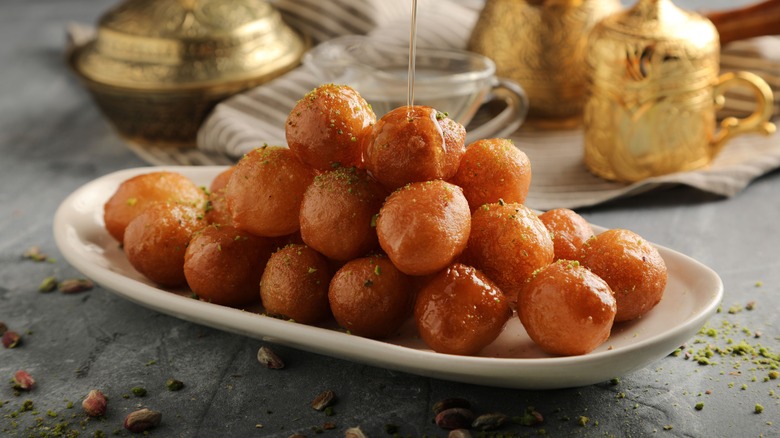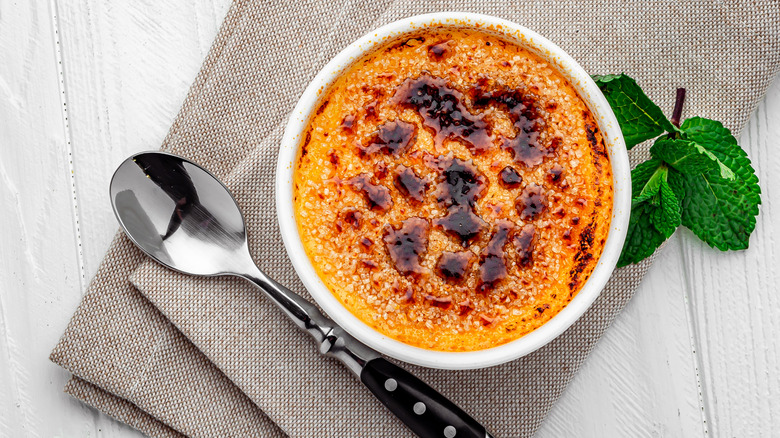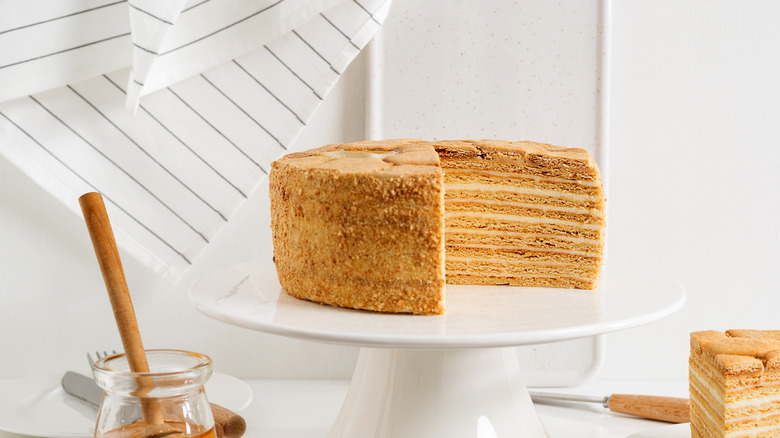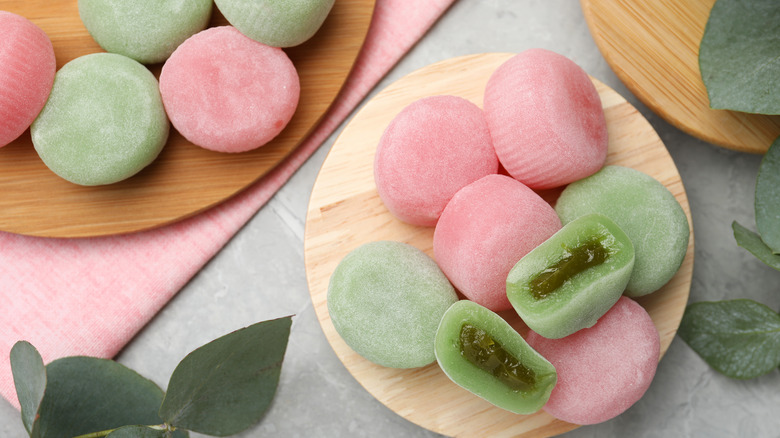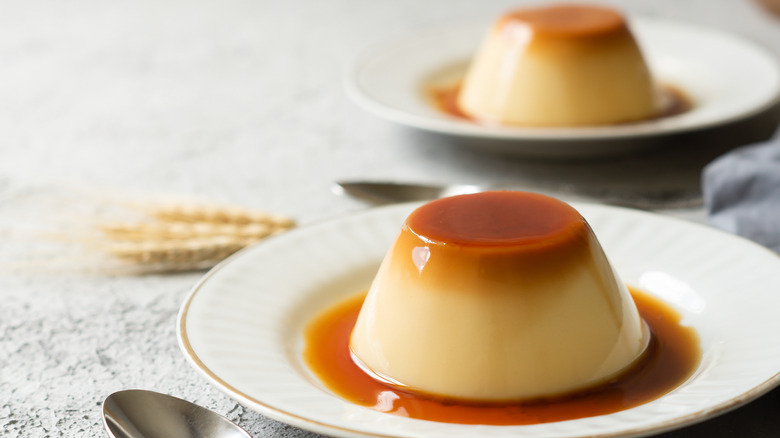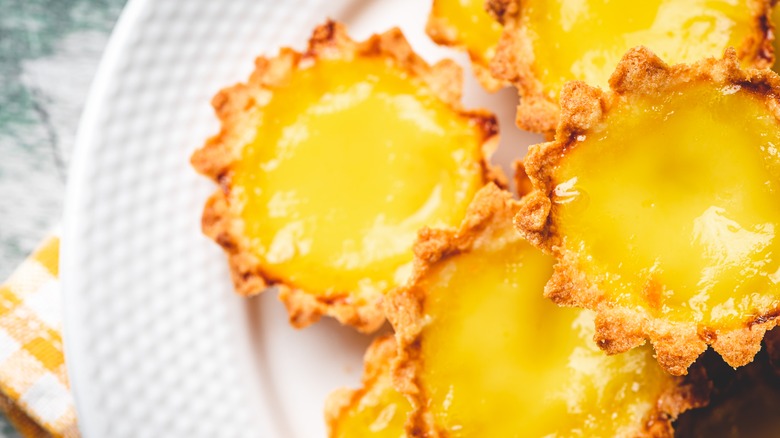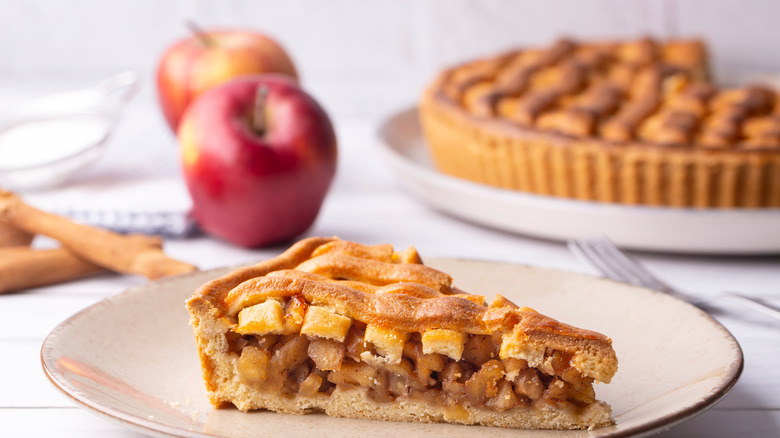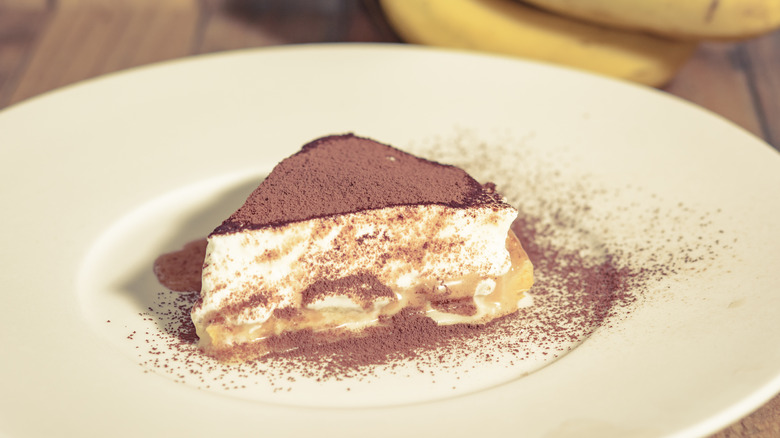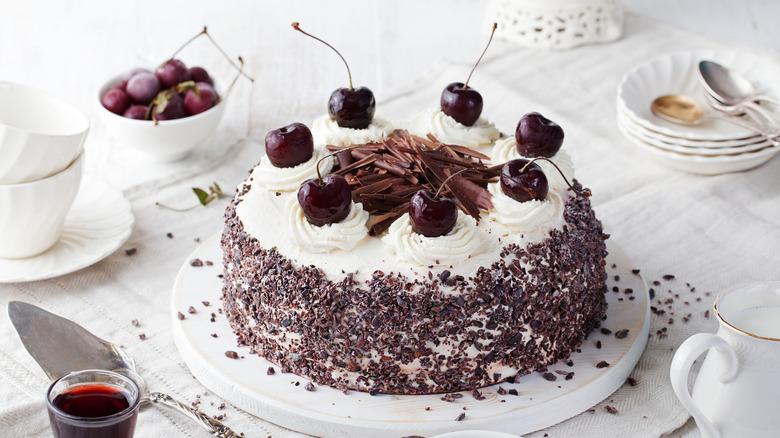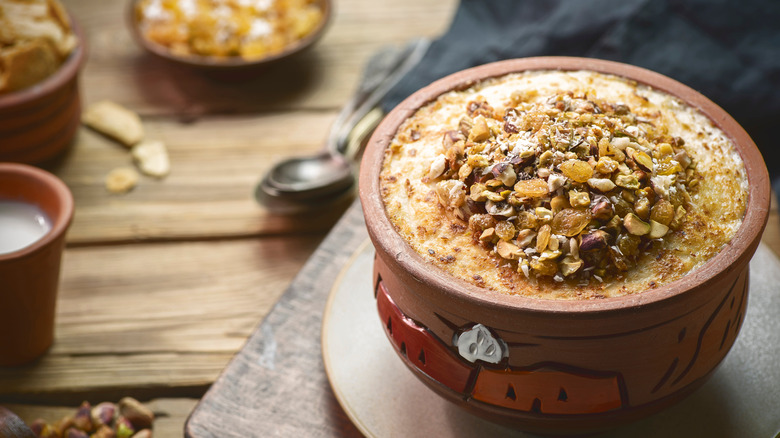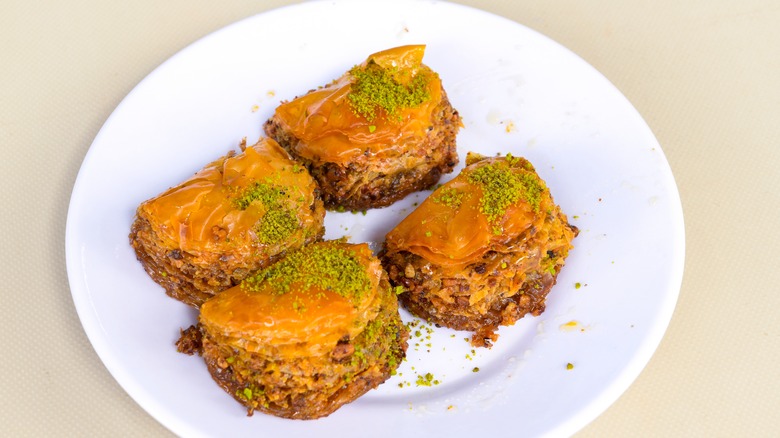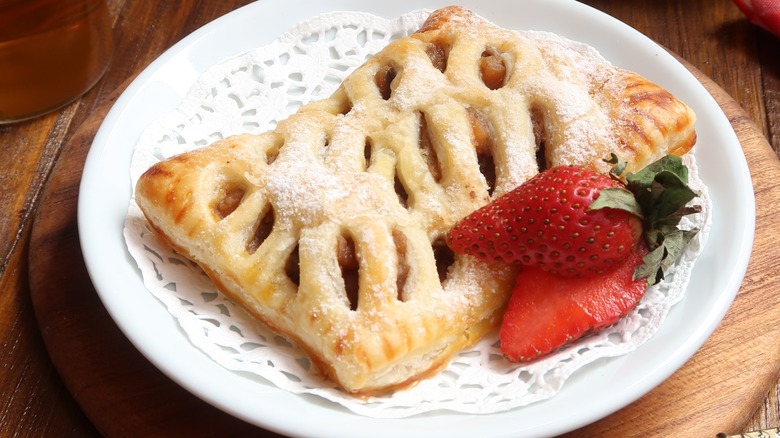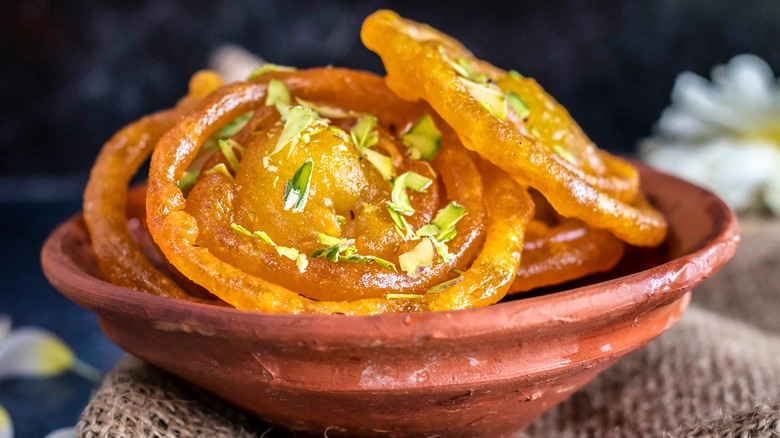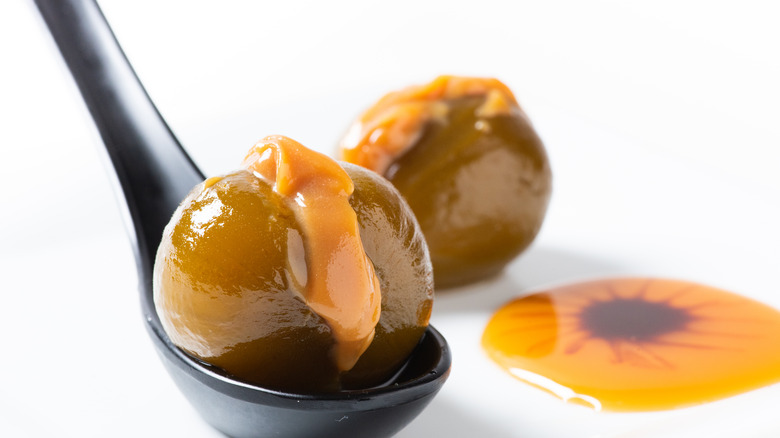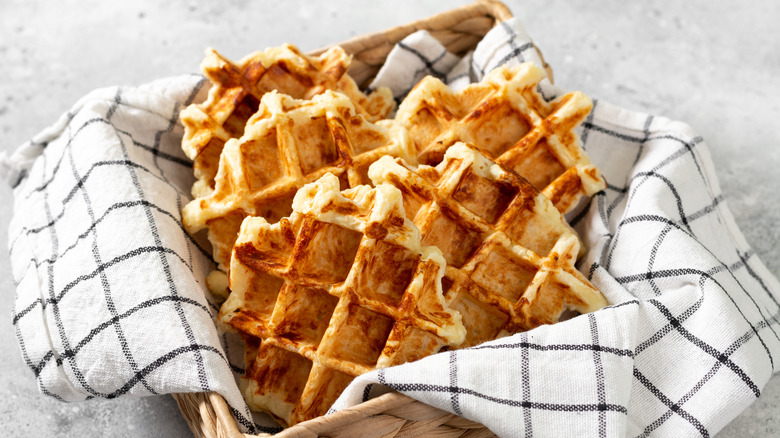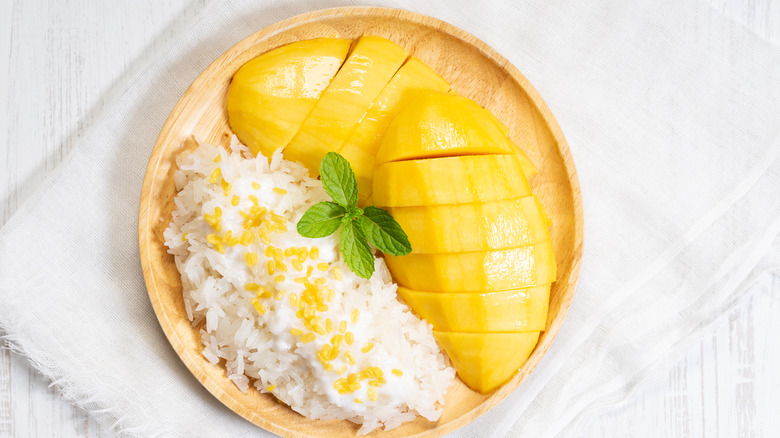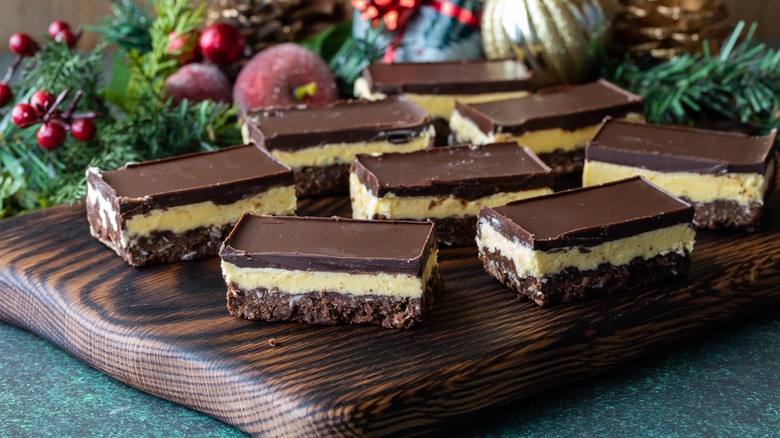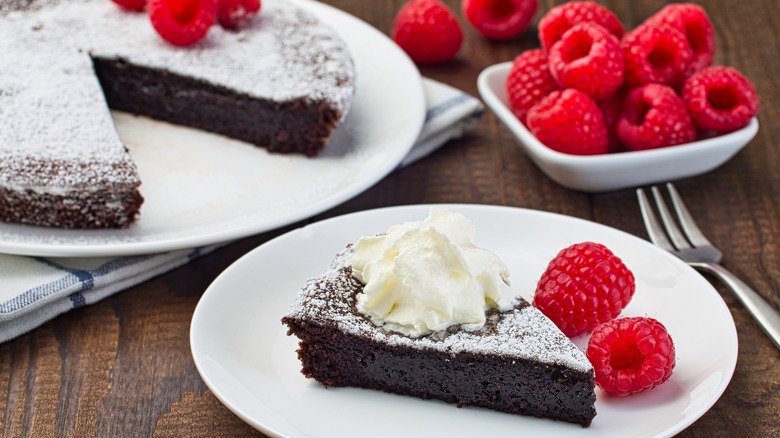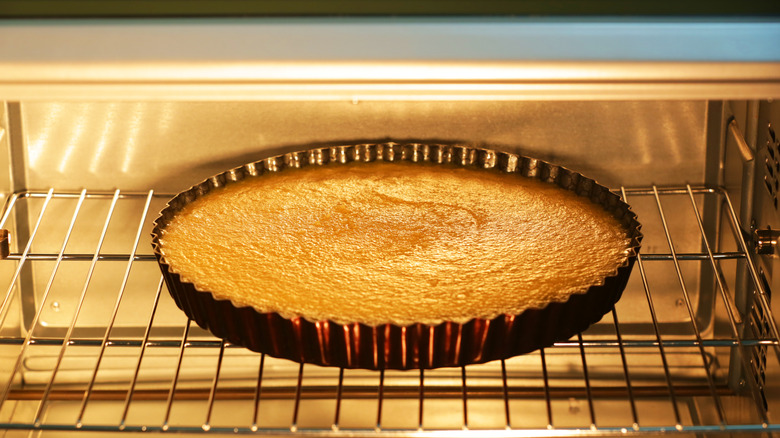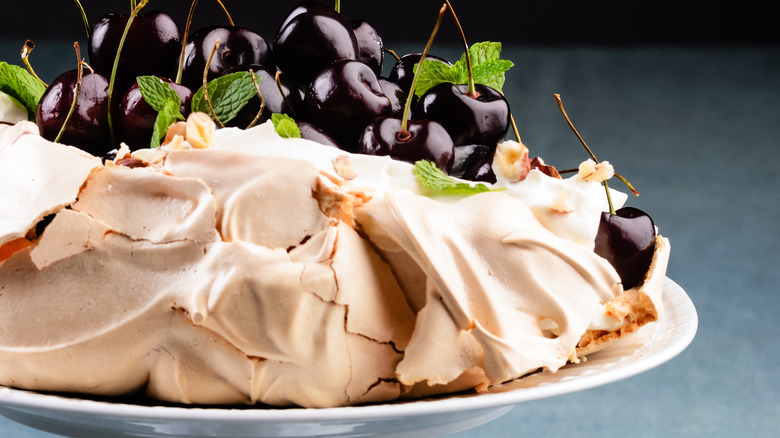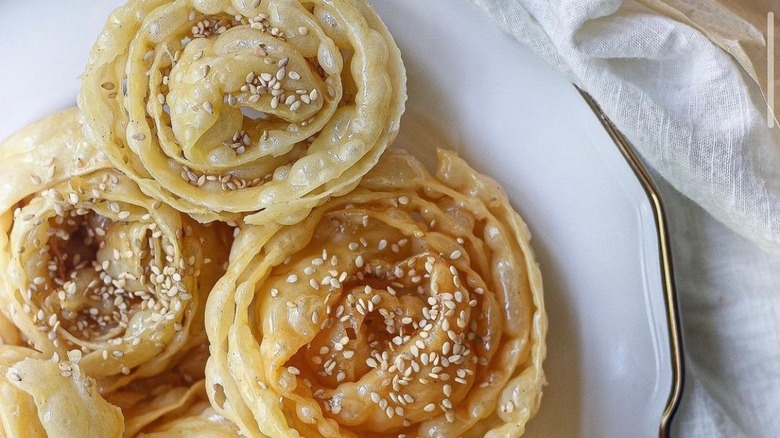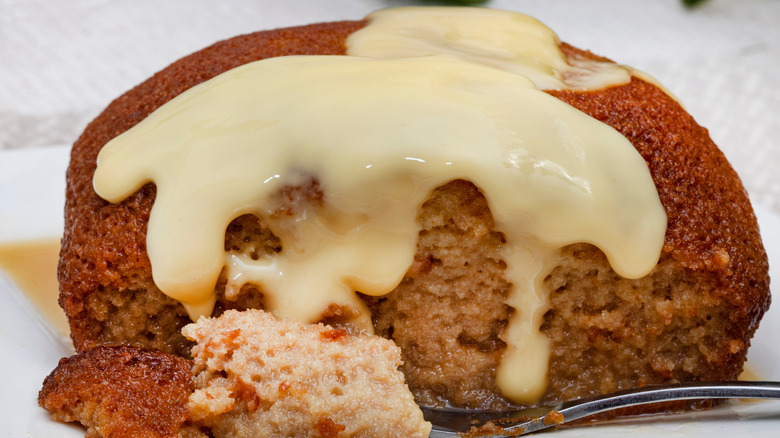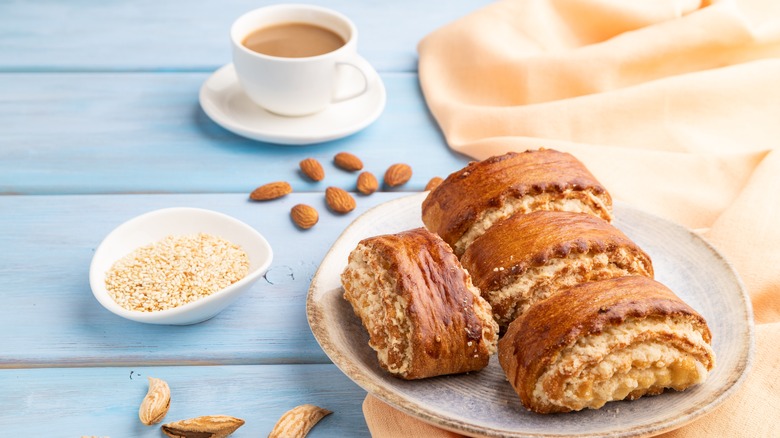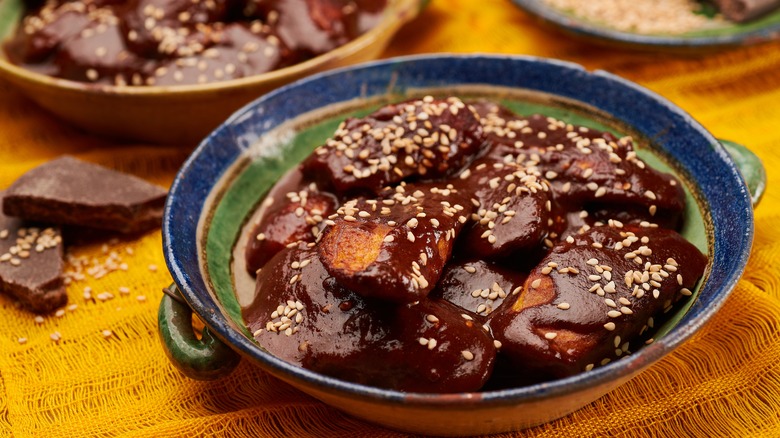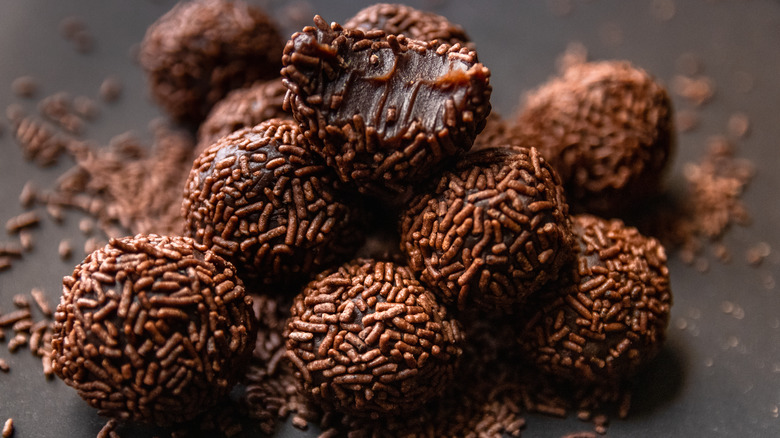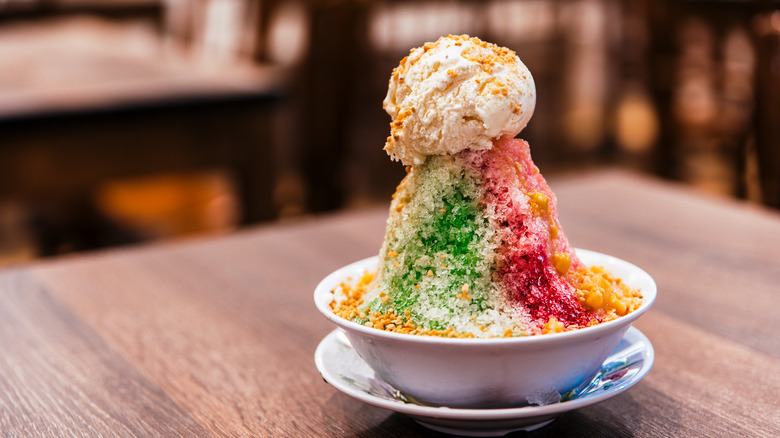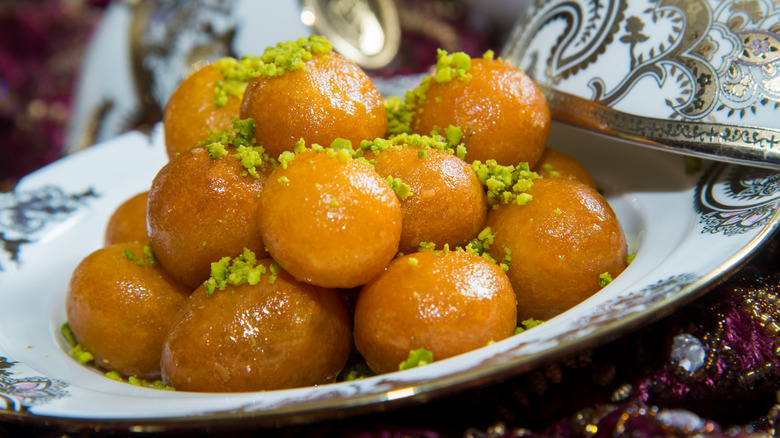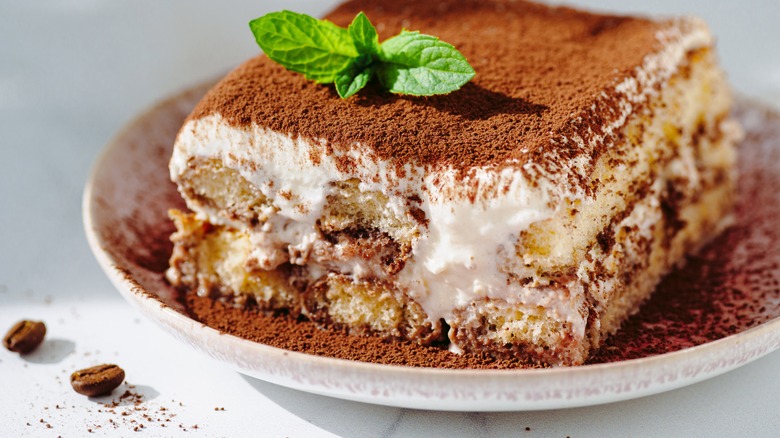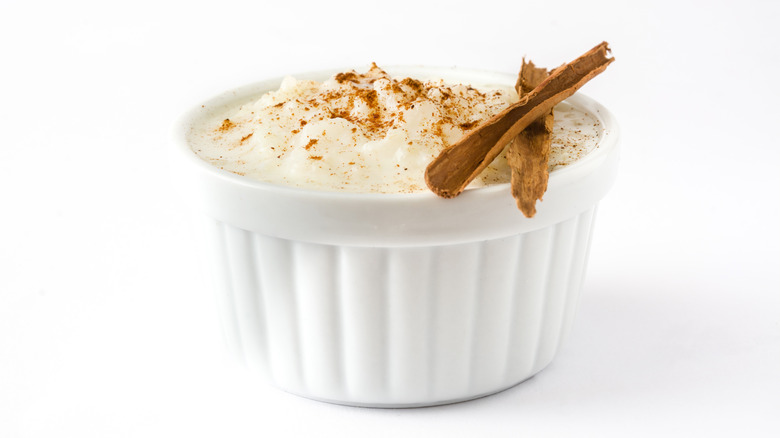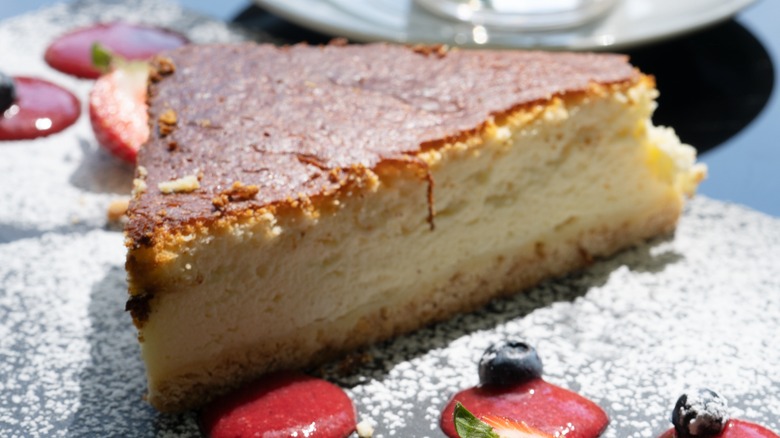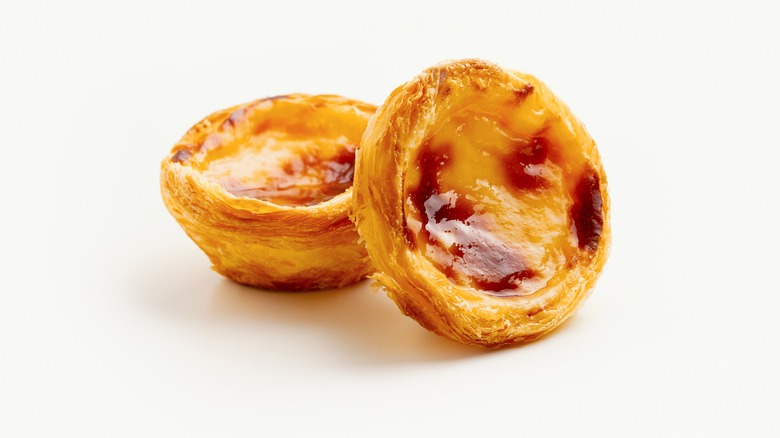Around The World In 30 National Desserts
We all can appreciate the "something sweet" after a dense main course, but the actual history of dessert is somewhat complex. According to JSTOR Daily, the French were the first recorded population to serve entremets — savory or sweet courses between main meal components. The word "dessert" itself is derived from "desservir," a French word which means "to clear the table." The first desserts were likely mild in sweetness compared to what we think of as "dessert" in the present; it wasn't until ingredients like sugar became widely available in the 18th and 19th centuries that hyper-sweet desserts took off.
A national dessert can say just as much about a country and its culture as much as a national dish can. And since every country has a different way to end a savory course or to celebrate a special occasion, you'll see a ton of diversity in dishes across the globe. Here are some of the most traditional national desserts from around the world.
Crème brûlée (France)
Crème brûlée is closely tied to French cooking, although other countries have tried to assert ownership over the custard. Classic crème brûlée is made by simmering heavy cream, egg yolks, vanilla, and sugar. Then, the mixture is baked in an oven until the custard solidifies. But, crème brûlée wouldn't be crème brûlée without a layer of cane sugar on the top of the custard and torching it to develop a dark color and texture that can be easily shattered with a spoon.
Medovik (Russia)
Medvoik is a beloved honey cake that can often go by names like "red cake," "little bee" and "honey fluff" (via the Moscow Times). In the home, the recipe for the honey cake, which is layered with homemade dulce de leche, is passed down from parent to child. The Moscow Times notes, however, that medvoik is not endemic to Russia originally but became popular during the Soviet era; the recipe first hit Soviet cookbooks in the 1960s.
Mochi (Japan)
Mochi is more than just the plush ice cream treats sold in the Trader Joe's freezer section. Mochi is made by pounding glutenous rice into a fine powder into a soft paste. The paste is then wrapped around fillings like fresh strawberries, sliced bananas, mandarins, sweet custard, or red bean paste to make dessert mochi. The mochi is then served with green, herbal, or fruit tea. StudyBreaks notes that mochi is an important part of the Japanese New Year celebration, as well as a religious offering for individuals practicing the Shinto religion.
Flan (Spain)
Flan is a popular dessert in Spain, as well as the countries that the Spanish have colonized or invaded across history. Spanish-style flan, otherwise known as caramel flan, has a creamy and custard base with a layer of sweet and bitter caramel on top. This type of flan is gelatinous, so it holds its shape after being removed from the mold and eaten with a spoon. In Spain, flan is often eaten on Christmas Eve (Noche Buena) or to commemorate special occasions.
Daan tat (China)
There might not be a more recognizable Chinese dessert than an egg tart, otherwise known as daan tat. These palm-sized desserts may look like the Portuguese egg tart, but they do not share any of the same lineages. However, the daan tat was inspired by British tarts frequently found in the southern Chinese port city of Guangzhou. Since custard was uncommon in the Chinese culinary experience, the Chinese bakers used egg, sugar, and milk. The shortcrust pastry crust was also modified to include widely available pork lard instead of butter. This gives the Cantonese-style tart a more flakey crust than other global variations of the dish.
Apple pie (United States)
As the phrase goes, "there's nothing more American than apple pie." And whether you enjoy eating your apple pie al a mode (with a scoop of ice cream) or with a crumb topping, you can take a bite knowing you're eating centuries of history in a dessert. According to The Culture Trip, American apple pie was first mentioned in written form in 1697's "America in So Many Words: Words that have Shaped America." And although the apple pie was popularized as a symbol of patriotism during the 1940s, the original recipe was ironically more the product of British, Swedish, and Dutch culinary influence.
Banoffee pie (United Kingdom)
While Britain may not have a "national dessert" per se, it does claim banoffee pie as one of its national favorites. According to Buddy Mantra, the word "banoffee" is a blend of "banana" and "toffee" — two of the dessert's main ingredients. Banoffee pie must contain a few ingredients to be considered banoffee pie, including a buttery base, sliced banana, whipped cream, a caramel or toffee layer, and occasionally ingredients like coffee or chocolate.
Black Forest cake (Germany)
Though it's commonly thought to be named after the eponymous region in Germany, the Black Forest cake actually gets its name from the Schwarzwalder kirschwasser traditionally used to soak the cake sponge with. Per regulations by the European Union, if a Black Forest cake does not contain this sour cherry brandy (which is otherwise shortened to "cherry kirsh"), it cannot be considered a proper Black Forest cake. Germans commonly enjoy their Black Forest cake with layers of cream and buttercream, along with the traditional decadent chocolate cake and sweet cherries.
Om ali (Egypt)
Om ali (or umm ali) is the national dish of Egypt. It resembles bread pudding but has a flakier texture because of the addition of puff pastry crust rather than conventional bread. The custard for the pudding is made with coconut, sugar, condensed milk, raisins pistachios, and almond flakes (via Times of India). The bread pudding is also flavored with aromatics like rosewater and orange blossom. Some recipes will garnish the om ali with crème fraîche as well (via Amuse). Om ali has remained one of the most popular dishes in Egypt eaten hot or cold.
Baklava (Turkey)
Baklava is a popular dessert dish across the Mediterranean and the Middle East. According to Great British Chefs, Baklava's origins trace back to the Ottoman Empire — which included present-day Turkey. Turkey is one of the most prominent consumers of this phyllo pastry dessert, which can be made with layers of chopped walnuts or pistachios, sugar syrup, and occasionally a semolina cream called kaymak (via Safir Bakery). Baklava can come in numerous shapes and sizes including triangular carrot slices or pistachio wraps rolled into cigar-sized rolls.
Apfelstrudel (Austria)
The Delanuay notes that apfelstrudel's prominence in the country's cafes, hearts, and stomachs makes it one of the national dishes of Austria. To make a traditional Viennese apfelstrudel, complete with the pastry's swirled pattern, a layer of filling must be spread between thin layers of unleavened dough. The word "strudel" is derived from the German word for "whirlpool." The most common type of filling for the strudel is apple, but there are other sweet and savory fillings that can also be found in Austrian cafes. Apfelstrudel is often served with coffee, tea, or occasionally champagne for special occasions.
Jalebi (India)
According to The Better India, the beloved jalebi sweet's origin was not in India, but in neighboring Persia. The jalebi is a descendant of zulbiya, a Persian dish made with an asymmetrical curl along with a garnish of honey and rosewater. Jalebi, in comparison, comes in circular shapes and is covered with a syrupy sugar coating. The base flour of this fried treat is a blend of wheat flour and gram (chickpea) flour spiced with cardamom and saffron. The dough also has a slight tang from the use of yogurt and baking soda. Once the batter is fermented, it is fried in hot oil and tossed in the syrup.
Brevas con arequipe (Colombia)
Brevas con arequipe is a traditional dessert served in Colombia. Lulo Colombia notes that these figs stuffed with dulce de leche, a caramel spread, are common in the Andes region of the country. You may also find dulce de brevas (or "higos"), which are figs covered in sweet sugar syrup made with panela — unrefined cane sugar. While there are other variations of this fig dessert in Latin America, Colombian dulce de brevas is unique in that it is served with a side of white cheese like queso fresco. It's a little sweet, a little savory, and all the more decadent.
Brussels waffle (Belgium)
Not all waffles are created equal, especially where the Brussels waffle is concerned. Brussels waffles are one of the most popular treats in Belgium. As a descendant of the Belgian waffle, the Brussels waffle is also made from a yeasted batter cooked on a hot iron. But the Brussels waffle is usually square compared to the circular Belgian waffle. The Brussels waffle also features deep pockets for syrup, chocolate sauce, or powdered sugar.
Mango sticky rice (Thailand)
Thailand's national dessert is unequivocally mango sticky rice. Thai sticky rice is often eaten after a meal in Thailand and resembles the same consistency as rice pudding. To make Thai mango sticky rice, short-grain rice is cooked with coconut milk, sugar, cinnamon, and salt until it becomes soft and sticky. Then, the rice is topped with fresh mango and occasionally herbs like mint. Some traditional preparations of Thai sticky rice also add a garnish of crispy mung beans (via Lifestyle Asia).
Nanaimo bars (Canada)
Have you ever heard of Canadian Nanaimo bars? It is believed that these treats were created in and named after the British Columbian city of Nanaimo. The first recipe appeared in a 1952 cookbook, according to British Columbia Magazine, and has since remained one of Canada's most beloved desserts. The Nanaimo bar is made with a base of graham crackers and coconut, custard, and a layer of chocolate on top. While there may be some variations on the exact proportions of the layers, many home bakers stick to a thick layer of custard sandwiched between the two other layers. You can find these bars in cafes, restaurants, and homes across the country.
Kladdkaka (Sweden)
Swedish kladdkaka is like a cross between a brownie and a molten chocolate cake. According to The Chopping Block, Kladdkaka is fudgy because it is made with a lot of melted butter. However, the cake itself is quite thin and must be slightly underbaked to maintain the plush, fudge texture it is known for. Kladdkaka is exclusively found in Sweden — except for furniture giant IKEA, which sells the cake in most of its cafes around the globe.
Basbousa (Jordan)
Semolina is a common ingredient in many dishes in the Middle East, so it's no surprise that Jordan's most famous dessert also contains semolina. Basbousa is a semolina cake made with coconut and yogurt, all soaked in sweet sugar syrup. The cake is often known to Jordanians as hareesh, and it can be baked in several small cakes or one large one. Some recipes soak the cake in orange blossom or rose water to develop unique aromas (via Tourist Jordan). The Foodellers note that babousa is often sold by street vendors and is often eaten with bare hands rather than a fork.
Pavlova (Australia and New Zealand)
Pavlova is the national dessert of both Australia and New Zealand. Both countries have staked claim over the origination of the dessert. The Australians claim the first pavlova recipe was made in a Perth hotel, while the New Zealanders claim a similar story happened in their country (via the BBC). In reality, neither of these countries may have been the first people to make a pavlova; other countries like Syria and Austria have similar forms of the dish.
This quintessential pavlova contains several components including whipped egg whites and sugar. The dessert is typically garnished with fresh fruit and may include a layer of fruit curd too. Pavlovas are frequently eaten during the summer or for special occasions.
Diblah (Libya)
Diblah (occasionally spelled deblah) is an airy fried dough made by twizzling thin strips of dough in a pan of oil until crispy. Once the dough is fried, it is dried and tossed in a mixture of honey and aromatics like orange blossom water and sprinkled with sesame seeds. You can find these fried desserts all year round in Libya and neighboring Tunisia, and they're served during Ramadan. "Deblah" means "engagement ring," but the dessert has a stronger resemblance to a flower.
Malva pudding (South Africa)
Malva pudding is an apricot-flavored cake made with egg yolks, butter, and apricot jam or preserves (via Delighted Cooking). The cake is often topped with a scoop of vanilla ice cream and is popular in the capital city of Cape Town.
Malva pudding was the direct result of colonization by the Dutch during the 1600s. Families resettling in the colonies brought their baking knowledge with them and were able to prepare jam from the abundant apricots in the region. While malva pudding is not popular in the Netherlands in the present day, South Africans have taken on this dessert as one of their own.
Gata (Armenia)
Gata is a common dessert found in Armenia. According to SBS, gata contains many regional variations depending on the part of the country its made in. But, you'll generally see the same plush, buttery pastry filled with a mixture of ghee, sugar, and Armenian rum or cognac.
Gata is a celebratory dessert often made for weddings. Per SBS, gata is typically given as a sweet gift and broken over the head of the couple for good luck. The bread can also be brought as good tidings for travel, or as celebratory food during the Christmas holiday.
Mole de plátanos (Guatemala)
Mole de plátanos are essentially Guatemalan plantains covered in mole sauce. The plantains are first sliced and fried in oil, then covered in a chocolate-based mole sauce. According to Lokal Travel, the dish was proclaimed part of the "Intangible Cultural Heritage of Guatemala" by the Guatemalan Ministry of Culture in 2007.
Mole typically focuses on savory ingredients, but Guatemala is the only country that prepares a sweet mole, otherwise known as mole en dulce. This sweet mole is thickened with sweet bread, panela, and handmade chocolate along with the traditional mole ingredients like chili, cinnamon, and sesame.
Brigadeiro (Brazil)
All chocolate lovers should try Brazilian brigadeiro. This dessert is a chocolate truffle made with condensed milk, chocolate, and butter. Brigadeiro was the product of a 1945 political campaign for Brigadeiro Eduardo Gomes (brigadeiro being Gomes' military rank). To help increase public support for Gomes, his party decided to design a dessert that would establish a connection between sweetness and the candidate (via SweetStone). The dessert became increasingly popular across Brazil, as well as other South American countries.
Ais kacang (Malaysia)
Ais kacang (otherwise known as "ais batu campur" in Malay) is a shaved ice dessert. Although other countries in Southeast Asia have their variations of shaved ice, ais kacang is unique because it features several different components including red beans, sweet corn, cendol, and grass jelly. To make the dessert, shaved ice is ground over the other ingredients. Then, the dessert is topped with sweet evaporated milk and drizzled with rose syrup or occasionally ice cream (via Halaman Sihat).
Luqaimat (Saudi Arabia)
Luqaimat is a Saudi Arabian dish that translates to "small bites" in Arabic. These small balls are made from fried dough sweetened with date syrup. You are most likely to find lunqaimat in Dubai during Ramadan, but some restaurants have added dessert to their menu year-round (via the Tenement Museum). According to the National News, luqaimat is unlike other types of dough because it is leavened with yogurt instead of butter or shortening. Luqaimat is often served with a sesame seed garnish or cardamom-and-saffron-infused syrup.
Tiramisu (Italy)
Italy's national dessert is often seen as a toss-up between tiramisu and gelato — and since Italy has such a large variation in culinary (and by proxy) dessert identity across the country, it's hard to pick one dessert. The classic tiramisu has grown outside of Italy's borders to be international in scope — and contains many of the same ingredients. This dessert is made with layers of ladyfinger biscuits dipped in coffee, layered with a thick mascarpone whipped cream.
Cuban rice pudding (Cuba)
According to Reference, arroz con leche was the product of the Spanish colonization during the 15th century. In addition to the standard combination of rice, sugar, and milk, the original recipe for arroz con leche included egg yolks, lemon rind, and cinnamon. While other variations of rice pudding exist in Mexico and Latin America, Cuban rice pudding is distinct because it uses sweetened condensed milk, and occasionally evaporated milk, for a sweeter flavor and thicker texture.
Sernik (Poland)
Polish sernik is a baked cheesecake. This cheesecake is not what you'd think of when you think of the word "cheesecake" because it's made with twaróg — curd cheese blended with eggs and sugar. The two main variations on sernik include the Viennese style, which is occasionally topped with chocolate and features raisins or sultanas with orange peel, and the Kraków, which is covered in a lattice pastry and prepared in a square pan.
Pastéis de nata (Portugal)
Pastéis de nata, otherwise known as Portuguese egg tarts, have a crispy, pastry exterior and creamy, thin custard interior. The top of these pastries is also scorched to add a bit of color and crunch. Pastéis de nata are baked in small tart tins to develop a crispy exterior that is both portable and flaky. According to Pearl River Mart, the Portuguese egg tart was first made by monks in the 13th century.
